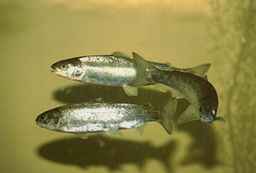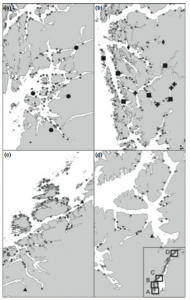Impacts of parasites on marine survival of Atlantic salmon: a meta-analysis
By Elana Rusnak, SRC Intern
In both wild and captive populations of Atlantic salmon, their most prevalent parasite in Norway, Lepeophtherius salmonis, or “salmon lice”, can have lethal effects on these fish. A common way to measure the overall effect these parasites have on smolt populations (young salmon making their first voyage from their home river to the ocean, where they mate) is to administer an antiparasitic treatment to one group, and leave an untreated control group at the beginning of their migration, and then recapture as many as possible on their return. Once recaptured, the salmon are analyzed for the number of salmon lice per fish, and then these data are sent into the Norwegian government for monitoring.

Figure 1: Atlantic salmon smolts. Their silvery color shows that they are ready to leave their freshwater home and migrate to the ocean, where they breed.
A study done by Vollset et. al. in 2015 reviewed all of the published and unpublished data and research that has been done on multiple Atlantic salmon populations in the rivers, oceans, and fjord systems in Norway. The purpose of amassing all of this data was to estimate the treatment effectiveness and survival of Atlantic salmon across studies, and to evaluate whether salmon lice pressure from salmon farms along the smolt migration routes affected variation in treatment effect. In total, the researchers used a dataset of 118 release groups dating from 1996-2011, comprising of 657, 624 fish released, and 3,989 recaptured.

Figure 2: Location of smolt releases along the coastline of Norway. Fish farms are indicated by gray dots. The various release locations are indicated by circles, squares, crosses, diamonds, and triangles, and they are grouped together based on pooling in the meta-analysis.
Complicated statistical meta-analyses were completed to analyze the large quantity of data collected by the researchers. Frequently, meta-analysis is considered to provide the highest level of evidence as to the effect of a treatment. The researchers attempted to take everything that could affect the results of the literature review into account, including heterogeneity (variance in estimates of treatment effect across studies), baseline survival (proportion of fish recaptured in the non-treated group), and publication, information, and selection bias. One of the most prominent tests they did was to calculate the risk ratio (RR) of the treatment in each release group. The risk ratio is defined as the probability of being recaptured in the treated group, divided by the probability of being recaptured in the control group. A higher RR means more treated fish were recaptured than control fish, which may show a correlation between the survival rate and the antiparasitic agent used on the fish.
After analysis, multiple variables were statistically significant at a p-value less than 0.2, including release location, release period, and baseline survival. Traditionally in science, p-values are usually considered significant at 0.05 or lower—so what does this mean? If a variable or result is statistically significant, it shows that there is a difference in what you are testing, or that a relationship exists. A lower p-value generally corresponds to a more significant result. Since this study claims significance at 0.2, it means that while the above variables had an effect on the result, it was not to an enormous degree.
With that being said, the researchers found that baseline survival was a major predictor of the results, suggesting that RR is high when survival in the control group is low, and RR is low when survival in the control group is high. Baseline survival was shown to also decrease when release location was farther away from the ocean—the fish have to migrate more in order to reach their breeding grounds, so they have higher exposure to parasites than fish migrating through shorter expanses of water.
What did the researchers conclude?
Overall, the results led the researchers to conclude that the antiparasitic treatment increases survival in the release groups. However, when taking all the varied data into account, the treatment was very beneficial in some groups, while in others, there seemed to be no effect on the return rate of the salmon. This variation could be explained by where the fish were released and the baseline survival. The meta-analysis supports the hypothesis that long-acting antiparasitic treatment can protect salmon smolts from salmon lice during outward migration and that salmon lice is a contributor to the mortality of salmon. Similarly, none of the salmon lice exposure estimates from the production of lice from fish farms had any significant effects on the RR estimates.
The results of this study show a significant, but small beneficial effect of the antiparasitic treatment on Atlantic salmon in Norway. However, the results do convey that salmon lice do contribute to the mortality of Atlantic salmon, and if they can be regulated, there is a possibility for higher rates of survival in the salmon. While this study is extremely narrow and specific, studies like this could lead to better management of both wild and cultivated populations of Atlantic salmon in other parts of the world. An understanding of the natural adversity that these species face could contribute to higher quality maintenance of fisheries and wild populations under conditions favorable to a high survival rate.
Paper referenced:
Vollset, K. W., Krontveit, R. I., Jansen, P. A., Finstad, B., Barlaup, B., Skilbrei, O. T., . . . Dohoo, I. (2015). Impacts of parasites on marine survival of Atlantic salmon: A meta-analysis. Fish and Fisheries, 1-17. Retrieved February 28, 2016.




Leave a Reply
Want to join the discussion?Feel free to contribute!